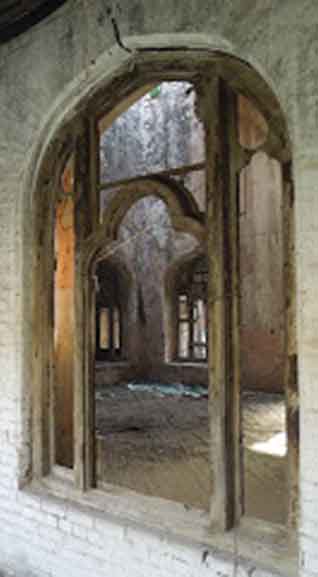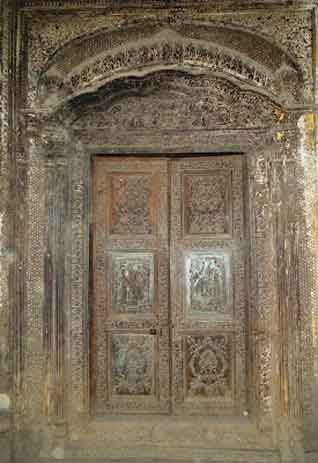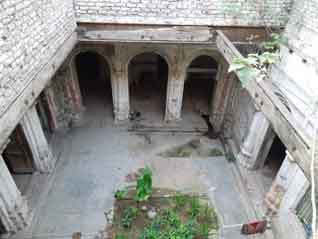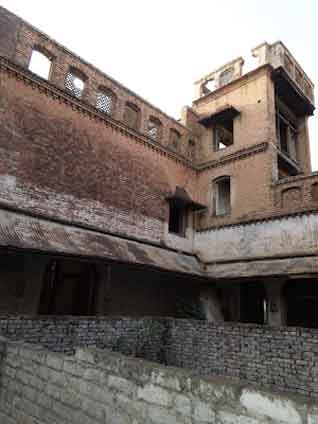Partition
Haveli Soojan Singh:
The Disappearing Sikh Heritage of Rawalpindi
SHIRAZ HASSAN
This is the voice of Rawalpindi – a city which has a lot to tell about its history and heritage -- but only to those who commit themselves to listening to the tales of this old city.
Recently a friend visited Islamabad/Rawalpindi. Like many Karachiites he had also heard of ‘boredom’ of the twin cities.
So, instead of spending time in the lavish restaurants in Islamabad, I decided to show him the real face of the city and not its facades – the old, but glamorous and sensational view of the city. We roamed around the different bazaars and streets of the old city of Rawalpindi. Thus started and continued our journey!
Wandering through the narrow streets of old city one could not ignore the amazing architecture of the pre-partition era – the magnificent buildings, beautiful wooden doors, the Chobaraas and Jharokhas.
Just imagine life here some 100 years ago when these areas were best known for the people who lived here! Gurdwara, mosque and temple, all in one lane, now that’s what we call pluralism!
But then, Partition wreaked havoc.
What happened at the time of partition is a heart wrenching, sad history. Today the narrow streets of the city force us to revisit history. They tell us a sorry tale of being neglected and in ruins but still holding itself – strong.
It is a glaring fact the old heritage and architecture of the city are in complete shatters today. Among the overcrowded and narrow streets of Bhabra Bazaar area of Rawalpindi there lies a historic landmark.
One of the most magnificent architectures of its time, Haveli Rai Bahadur Soojan Singh. But … Alas! the dilapidated condition of the haveli shows the gloomy picture of heritage crumbling right in front of our eyes and our negligence towards preserving history and its landmarks.
Haveli Soojan Singh was built by Rai Bahadur Soojan Singh in 1893 as a residence for his family. He was a distinguished personality of his era, a wealthy business man in Rawalpindi who had a flourishing timber business. He had a unique sense of architecture and design.
But this house was not just another Haveli. It was a living museum – in a class of its own.
The Haveli was deliberately decorated with pictures of Rai Bahadur’s family, antiques, Victorian furniture and a milieu of silver and gold-ware decorated its walls.
The four storied building is divided into two parts on either side of the street and the roof connected through a bridge supported by iron mudguards/railings and decoratively covered with wood.
The wooden artwork on the roof, floors and windows is just marvelous.
The covered area of the haveli was 24,000 sq.ft (2,230 sq. meters) spread over four stories comprising of 45 rooms lit on evenings by huge lamps and chandeliers.
According to historians, the haveli glowed and sparkled like gold in the evenings when all these lamps and chandeliers were lit in all its massive rooms spread over such a huge area.
Historians also say that it was almost like a royal palace with a majestic throne made of gold and bedrooms furnished with ivory furniture. In the courtyards tiptoed peacocks and a tiger strolled through its corridors. Live music filled the haveli in the evenings. The haveli had its own water supply system with a water-well connected to 30 lines.
Ms Shehla Shams, a student of Fatima Jinnah Women University, writes in her thesis on the Haveli:
The Soojjan Singh Haveli was initially built as a residence for the Rai Bahadur’s family but then it was given to the Sikh generals to be used as a residential headquarters. It is a two-storied building with two viewing decks on the third and fourth floors that were probably built as lookout posts by Sikh soldiers in the 19th century.
Made from brick and timber, the Haveli reflects traditional building styles of the Sikhs of that era. The timber used was local and must have been easily procured since the Singh family had a flourishing timber business. The iron used in the pillars and embellishments of the doorways was imported from UK.
One thing that stands out about this building is that the staircase remains the same from the ground floor up to the fourth floor. The embellishments of the Haveli borrow a lot from Central Asian and European architectures. One finds intricately carved wooden false ceilings on the first floor. The pattern on the panels is clearly Central Asian and follows the same patterns as the Sethi Mohallas in Peshawar.
Over the years since partition of the Indian Subcontinent it has housed refugees from Kashmir until General Zia-ul-Haq had it vacated; handing it over to nuclear scientist A.Q. Khan to house a science college for girls but that project for some reasons did not see the light of the day.
Later the former Railways Minister Sheikh Rashid Ahmed decided to turn it into a campus of the Fatima Jinnah Women’s University. However this plan too could not materialize due to its present overcrowded location in a busy commercial area.
Now, the government is mulling over an idea of starting a School of Cultures, Heritage, Architecture and Designs for girls. This project too may be shelved as there are no funds available for it.
The splendid haveli of Rai Bahadur Soojan Singh is in utter shambles these days due to lack of proper maintenance. One part of the haveli is completely damaged. Several parts of the roof have collapsed and other parts are also fragmented. The majestic wood-work over the doors and windows are now being eaten away by termites and seepage through the walls has made the whole structure of the building weak, raising fears that it could fall apart any day.
The grand rooms and halls which were once bright and echoed of gossip, music and laughter now lie vacant wearing a ghostly shroud. The haveli requires extensive renovation efforts to restore it to its original glory. Today, in place of the dazzling structure stands a haunted bungalow. One can sense the grandeur of its beauty in spite of the skeleton that it is today as through the passage of time, it has been robbed and looted of its shimmering ornaments.
However, it is obvious that among all the hue and cry raised by politics one cannot expect that Haveli Soojan Singh to really ever return to its glorious past. It is as if we are knowingly sending it on its way to a complete oblivion, a total wipe-out from the landscape of our collective memories.
With the current situation of the country where politicians seem to have other, more important priorities, will the dying haveli ever be restored to its youthful charm?
I don’t think so. Nothing more heart-wrenching and frustrating than to see a living witness to history and our own heritage crumbling to dust and we are unable to do anything at all!
[Courtesy: We Blog The World. Edited for sikhchic.com.]
October 18, 2013
Conversation about this article
1: Kaala (Punjab), October 17, 2013, 12:35 PM.
Sikhs have lost everything they won or created after paying a huge price in sweat and blood. Was there a need to pay that price if we were not to retain anything? Something must be very wrong with our plan. We need to some serious introspection.
2: SSN (USA), October 17, 2013, 2:10 PM.
Any descendent of Soojan Singh reading this? My family moved from Rawalpindi in '46/'47. What of our land, house? My grandparents never spoke of it. My parents/ uncles / relatives don't talk about it or know little. I know nothing. Any reader out there doing research on Sikhs from Western Punjab?
3: Surat Singh (Kitchener, Ontario, Canada), October 17, 2013, 8:20 PM.
Re #2: Does anybody know if Sardar Khushwant Singh's grandfather was the Sardar Soojan Singh referred to here?
4: Sarvjit Singh (Millis, Massachusetts, USA), October 18, 2013, 12:48 PM.
This haveli was built in the 1890s, per the author. To the best of my knowledge there were no Sikh generals around at that time. It was the British Army Garrison in Rawalpindi. Also, per Khushwant Singh's book, his family came from a village called Hadali. That might help in clarifying. Sadly, there is nothing that can be done now about our heritage being held in alien hands in Pakistan. There is no public support or any intention on the part of the Pakistanis to preserve non-Muslim heritage. It would defy their history. Instead, we could focus on building our heritage and self-preservation in the US, UK and Canada, etc., and channel our energy into the diaspora.
5: R Singh (Canada), October 18, 2013, 2:40 PM.
SSN (USA): Try some journalists who write for the Dawn newspaper. The page, "Exploring Rawalpindi/Islamabad," might be of help.
6: Gurjender Singh (Maryland, USA), October 19, 2013, 12:19 AM.
We are worried about heritage in Pakistan , but the SGPC is destroying our heritage in Punjab ... such as the original brick wall where Guru Gobind Singh ji's younger sons sons were buried by the Mughals; it has been replaced with marble.
7: Shiraz Hassan (Rawalpindi, Punjab, Pakistan), October 29, 2013, 5:25 PM.
Dear Sarvjit Singh and Surat Singh: Soojan Singh of Rawalpindi was not related to Khushwant Singh. Yes, there were no Sikh generals in the army at that time but Sikhs held major business positions during that time in the city. Dear R Singh: That Facebook page 'Exploring Rawalpindi/Islamabad' is run by me as well.
8: Karamjeet Singh (Chicago, Illinois, USA), December 25, 2013, 12:21 AM.
Shiraz Hassan is doing a fine job of connecting historical dots. I follow him on Twitter. Why Pakistan is not able to maintain its heritage is understandable, but if they maintain it, there could be a large tourist traffic to the cities ... like that of the havelis of Rajasthan. Sikhs and Punjabis would love to visit in hordes, provided these sites are well kept and maintained. Governments can and do -- as has Pakistan already -- take advantage of Unesco funding for such projects.
9: MBN (Rawalpindi, Punjab, Pakistan), February 15, 2014, 9:28 AM.
http://www.dawn.com/news/1085201/sujan-singh-haveli-to-be-refurbished-by-nca - RAWALPINDI: The majestic 124-year-old Haveli Sujan Singh, used by the Fatima Jinnah Women University (FJWU), will soon be renovated by the National College of Arts (NCA).
10: Chaudhary Fakhar Zaman (Oxford, England), May 22, 2014, 6:01 PM.
My late father's efforts saved this building and it was declared a national listed building. I've been to the house of Sardar Soojan Singh back in 1994. They used to live on Kasturba Gandhi Marg in New Delhi. His grandson Sardar Gurbachan Singh who was Ambassador of India to Switzerland passed away last year. I also belong to one of the oldest families of Rawalpindi and my grandfather was municipal commissioner, honorary magistrate and also Zaildar of Rawalpindi City. I've grown up near Bhabra Bazar. My late father who passed away in January kept all the pre-partition contacts alive and was a regular visitor to India to meet up with old friends. After his death I am trying to keep those contacts alive to the best of my ability and dear 'SSN", if my dad was alive he would definitely have taken you to your house but nevertheless, if you contact me via email chhashmat@hotmail.com and let me know the names of your ancestors, I'll try to help you out. Lastly, my father's name was TARIQ AZAM CHAUDHARY, and he was an advocate of the Supreme Court of Pakistan.
11: Shahid Shabbir (Islamabad, Pakistan), August 17, 2014, 1:34 AM.
I am doing work on Sikh Heritage in Pakistan. Please come and visit ... hope you like my effort: https://www.facebook.com/savehistoricalplacesofpakistan?ref=hl
12: Adnan Alam Awan (Islamabad, Pakistan), January 24, 2015, 11:29 AM.
Thanks very much for this very informative article. I visited this haveli toady (January 24, 2015) and was totally lost in its magic. I have also found that still no preservation work has been started by any organization or college, it should be preserved and made a museum for coming generations.
13: Manav Singh (India ), February 16, 2015, 1:31 PM.
I'm Sardar Bahadar Sujan Singh's great grand son. My email address is Manav@ImperialHolding.in. I would like to see my ancestral haveli some day and will be glad to contribute in some way towards its restoration.
14: J Durrani (Pakistan ), December 03, 2015, 8:36 PM.
The latest information regarding Soojan Singh's Haveli is that the National College of Arts, Rawalpindi, has taken up the task of renovating it. http://tribune.com.pk/story/993354/architectural-preservation-nca-students-teachers-step-up-to-save-sujan-singh-haveli/
15: Pammy Kaur Kohli (New Delhi, India), December 11, 2015, 11:43 AM.
As the grand-daughter of Sardar Sujan Sing of Rawalpindi, I have heard wonderful descriptions of my grandparent's haveli. I have heard that it was beautifully designed with exquisite carved woodwork, and that there were frescoes by Afghan artists on the ceilings, and crystal chandeliers. There was a gurdwara supported by my grandfather nearby and the entire market on the street where the haveli is located, is said to have been owned by him.
16: JK Singh (Toronto, Ontario, Canada), August 31, 2018, 11:06 PM.
Sardar Sujan Singh was my great great grandfather. I'm hoping someone can tell me whether Bagh Sardaran is still around.






